Arctic Tundra Biome

Frobisher Bay near Baffin Island (RyersonClark, iStockphoto)

Frobisher Bay near Baffin Island (RyersonClark, iStockphoto)
How does this align with my curriculum?
Learn about the location, plants, animals, human impacts and conservation of the arctic tundra biome.
The Terrestrial Biomes
The terrestrial world can be divided into areas called biomes. A biome is a large area of land classified by its plants and animals.
A biome is made up of many ecosystems. An ecosystem is the interaction of living and nonliving things in an environment.
Misconception Alert
An ecosystem is not the same thing as a biome. Biome is the specific geographic area in which ecosystems can be found.
In this backgrounder, major terrestrial biomes of the world are named based on the Whittaker classification scheme. This is not the only classification system because scientists do not all agree on the number and types of biomes.
Distribution of the Earth’s Major Biomes
The map below shows where each of the eight major terrestrial biomes are located in the world. Canada contains four biomes. These are temperate deciduous forest, grassland, boreal forest/taiga, and tundra. A biome has the same characteristics no matter where in the world it is found. This means that the boreal forests of Canada look like the boreal forests of Russia.
The characteristics of each biome are dependent on its climate. Temperature and precipitation are the most important factors determining what living things can be found in a given biome. In this chapter, we will explore five biomes: rainforest, savanna, desert, boreal/taiga, and tundra.

Major terrestrial biomes (Let’s Talk Science adapted from an image by Adapted from: H.J. de Blij and P.O. Miller. 1996. Physical Geography of the Global Environment. John Wiley, New York. Pp. 290.)
Image - Text Version
Shown is a colour world map illustrating the location of terrestrial biomes.
The map shows the world's oceans in blue, and its landmasses in stripes and blobs of eight different colours.
A legend on the right side identifies the biomes associated with each colour. Red is labelled "Tropical Rainforest." Yellow is labelled "Savanna." Gold is labelled "Grassland." Brown is labelled "Chaparral." Pink is labelled "Desert." Dark green is labelled "Temperate Deciduous Forest." Bright green is labelled "Boreal Forest/Taiga." Purple is labelled "Tundra."
Starting at the top, purple indicates Alaska, Canada's arctic, the tip of Greenland, Northern Russia, a strip close to the west coast of South America, and part of Central Asia, are tundra.
Below, most of southern Canada and Russia are bright green for boreal forest/taiga.
A gold blob in the middle of North America, another on the southeast coast of South America, a strip in an arc shape across part of the Middle East and southern Russia, a small part of the southeast coast of Africa, and small parts of the west and south coasts of Australia, indicate grassland.
Dark green appears on the west and east coasts of North America, the west coast of South America, large parts central and southern Europe, the UK, eastern Asia, the southeast corner of Australia, and all of New Zealand. This indicates temperate deciduous forest.
Pink areas are across the western United States, northern Mexico, a narrow strip of South America, most of North Africa and the tip of South Africa, Central Asia and the middle of Australia. These indicate desert.
The brown areas are small and scattered widely. They are along the southwest coast of the United States, the northeast coast and southern tip of Africa, most of Italy, Greece and Turkey, and small parts of southern Australia. These indicate chaparral.
Red is scattered across parts of the southern hemisphere. This includes Central America, northern parts of South America, a thin strip across most of Africa and the northern tip of Madagascar, most of Southeast Asia and the northeast tip of Australia. This indicates tropical rainforest.
Yellow is in two blobs in South America, most of the southern half of Africa, most of India, a small strip of Southeast Asia, and the northwest coast of Australia. This indicates savanna.
Arctic Tundra
Location
The arctic tundra biome is the northernmost biome. It covers the lands north of the Arctic Circle up to the polar ice cap. It reaches as far south as the Hudson Bay area of Canada and the northern part of Iceland. It covers approximately 11.5 million km2. Alpine tundra is found on mountains. Antarctic tundra is found on Antarctica and the surrounding Antarctic islands.
Description
The arctic tundra is a vast, dry, rocky place, with few trees. The word “tundra” comes from the Finnish word tunturi. This word means ‘treeless plain'.
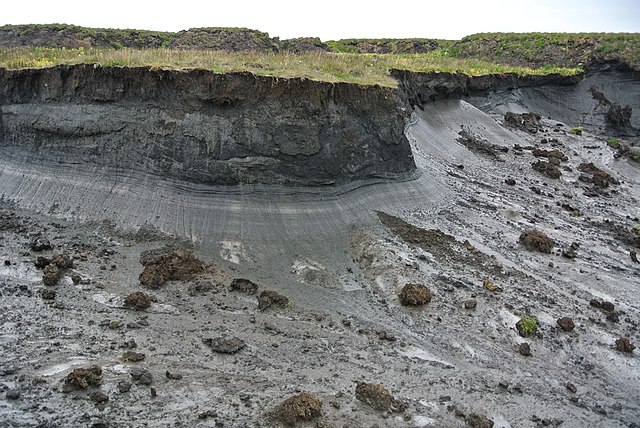
Thawing permafrost on Herschel Island off the north coast of the Yukon in the Beaufort Sea (Source: Boris Radosavljevic [CC BY-SA 2.0] via Wikimedia Commons).
Image - Text Version
Shown is a colour photograph of an area of melting permafrost.
The colour image shows the exposed underground layers of soil and rocks under a layer of grass. The exposed layers take up 3/4 of the image. In the top 1/4 of the image there is a line of green and brown grass. In the background of the image there a few low rocky hills. There is a strip of white sky at the very top of the image.
The exposed underground layers are a mix of dark grey and black. The bottom half is covered in medium sized boulders. The top half of the exposed layer is a steep drop without any boulders on it. Where the top and bottom of the layers meet there is a layer of grey with light coloured lines running through it.
The ground in the arctic tundra tends to be rocky and the soil has few nutrients. This is because the organic matter there breaks down very slowly.
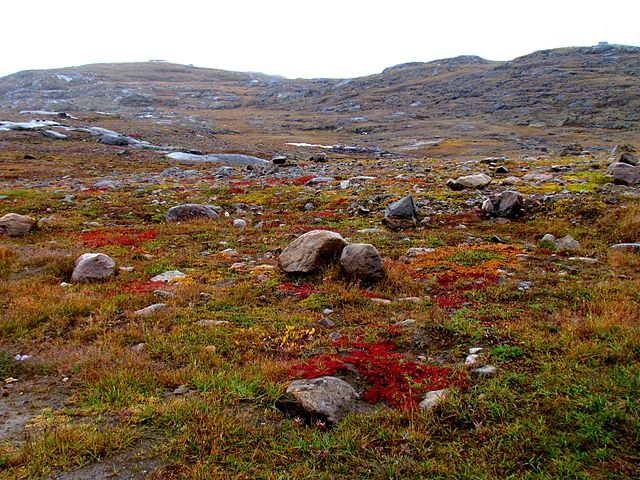
Typical arctic tundra landscape in Nunavut (Source: ADialla [CC BY 2.0] via Wikimedia Commons).
Image - Text Version
Shown is a colour photograph of an area of the arctic tundra landscape.
The image is viewed at ground level. The foreground shows grasses and plants of different colours, including tan, yellow, orange, red and green. Amongst the grasses and plants there are tan and grey boulders of varying sizes from small to large.
In the background there are a few low, rocky hills covered in tan grass. Above the low hills there is a small strip of white sky.
Due to its northern location, the arctic tundra has a very cold climate. Temperatures range from 15.5 °C in summer to -60 °C in winter. Mean temperatures are below 0°C for six to 10 months of the year.
Summers are also much shorter than winters. The northernmost part of this biome experiences close to 24 hours of sunlight in summer. It experiences close to 24 hours of darkness during parts of the winter. The annual precipitation is around 150 to 250mm. Most of this precipitation does not evaporate due to the low temperatures. Melting permafrost makes soils very soggy in the summer.
Plants & Animals
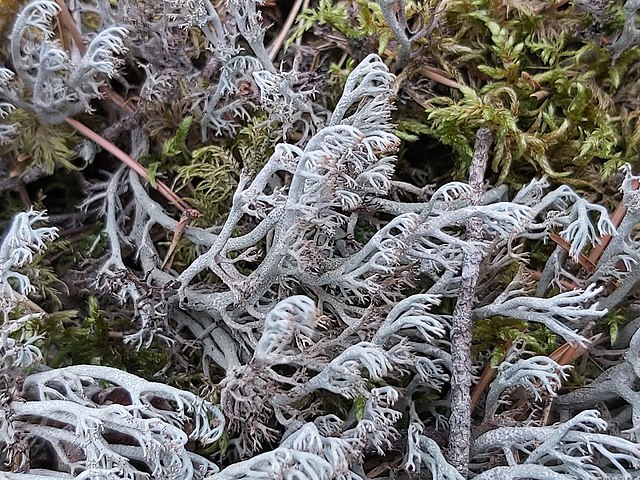
An example of reindeer moss (Source: Tomas P [public domain] via Wikimedia Commons).
Image - Text Version
Shown is a colour photograph of a small patch of reindeer moss.
The image is a fairly close-up perspective. The entire image is taken up with a plant that consists of stem-like columns with spindly branches coming off. These plants are a very light grey colour, almost white. The spindly branches are sparser at the base and more full at the top of the stem-like columns. The spindly branches are all pointed to the right of the image. Amongst these, there are also a few small light brown sticks and some green moss. The moss is mostly seen behind the light grey, white plants.
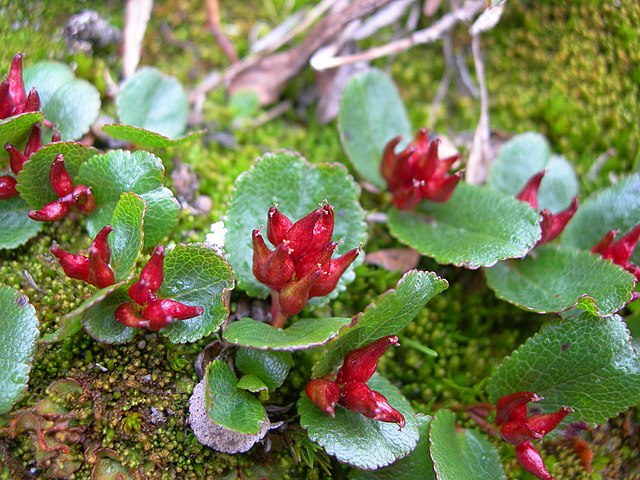
Dwarf willow (Salix Polaris) getting ready to flower in Nunavut (Source: Qaqqaqtunaaq [CC BY] via Wikimedia Commons).
Image - Text Version
Shown is a colour photograph of a small patch of dwarf willow about to flower.
The background of the image is a yellow and green moss. At the top of the image there is some stick-like organic matter, slightly out of focus.
Taking up the majority of the image from just below the top left corner, through the middle and down to the right hand corner are some plants. The plants have oval-shaped leaves with a bumy texture. The edges of the leaves are are slightly serrated. Tucked in the middle each pair of leaves are glossy, red cone-shaped seed pods. The two middle plants each have six of these pod. The nearby plants have fewer pods.
Did you know?
The Inuit word for Dwarf willow is Quarait.
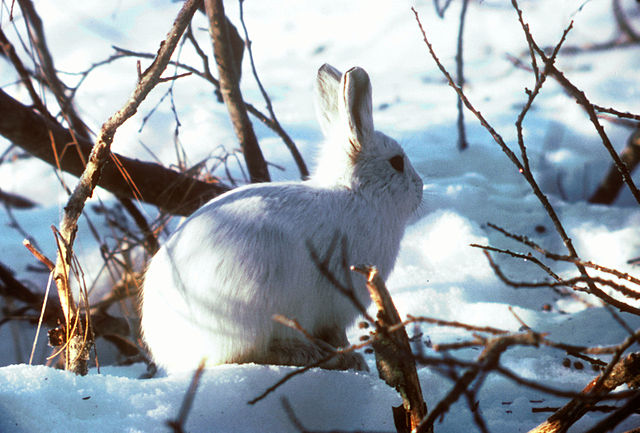
Arctic hare in winter (Source: U.S. Fish and Wildlife Service [public domain] via Wikimedia Commons).
Image - Text Version
Shown is a colour photograph of an arctic hare in the snow.
The hare is sitting in the centre of the image. It is white with dark grey ears and black eyes. Only one eye can be seen because the hare's back is facing forward and its head is pointed toward the back right of the image.
In the foreground and back ground there are woody sticks standing upright and laying on the snow-covered ground.
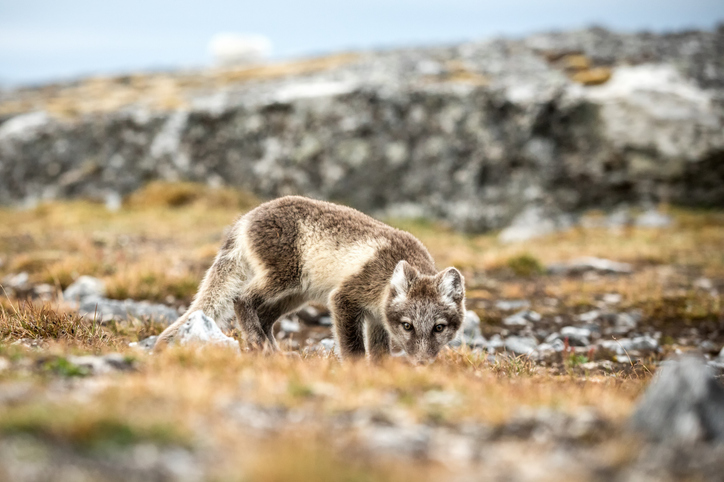
Arctic fox in summer (Source: Jiri Hrebicek via iStockphoto).
Image - Text Version
Shown is a colour photograph of an arctic fox in the arctic summer.
The image is viewed at ground-level. The foreground is out of focus and it shows rust coloured grasses with a few green tufts. In the right front corner of the image, amongst the grass, there is an also out focus grey boulder.
The background of the image is out of focus. There is a small grey, white and black cliff. There is also patches of rust coloured grass along the top of the cliff. The left side of the cliff is less tall. It grows gradually taller from left to right and almost fills the right hand corner. Above this cliff there is a small slice of blueish grey sky.
In the middle of the image, which is in focus, amongst more rust coloured grass and grey rock rocks there is an arctic fox. The fox has its head low to the ground and is facing the camera straight on. The tip of its muzzle is hidden by the grass.
The fox has dark brown legs. Its hindquarter, forequarter and back are light brown. Its stomach and ribs are a light cream colour. The fox's face is a dark grey with dark brown lines down each side of its muzzle. The fox's eyes are black. The top of its head is light brown and the back of its ears are also light brown but the inside of its ears are white.
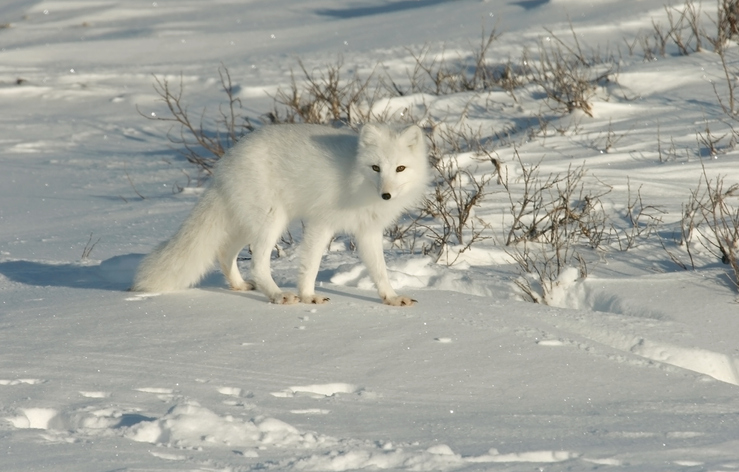
Arctic fox in winter (Source: milehightraveler via iStockphoto).
Image - Text Version
Shown is a colour photograph of an arctic fox in the winter.
The image is viewed at ground-level. The foreground is snow covered. There are track marks in the front left corner. The track marks disappear slightly after the centre of the image.
In the background there is more snow with small grasses poking through. The plants have dark blue-ish grey shadows to the left of them. Amongst the background there are more track marks.
In the middle of the image, directly in front of the woody sticks there is a white fox. The side and head of the fox are facing the camera. The fox's tail and body fur are fluffy. The fox's eyes and nose are black. It has pale brown feet with dark coloured claws.
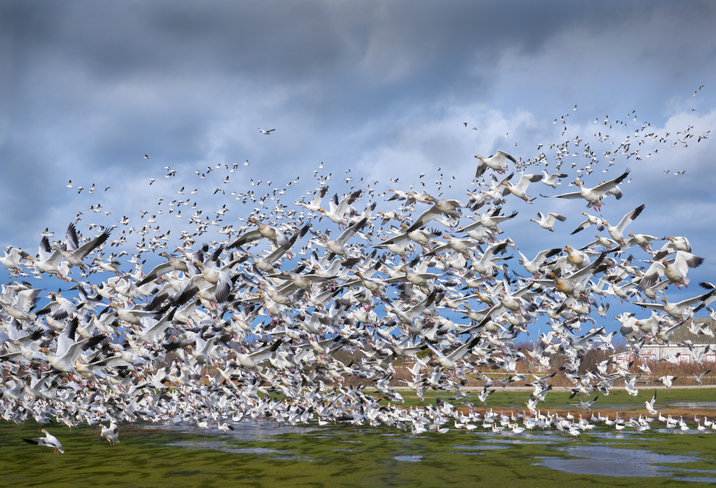
Huge flocks of snow geese fly to the tundra in the summer (Source: Maxvis via iStockphoto).
Image - Text Version
Shown is a colour photograph of a flock of geese.
The foreground of the image is comprised of a small strip of green land with small pools of water interspersed. The largest pool of water is found in the front right hand corner.
In the middle of the image there are some geese. Some of the geese appear to be on the ground amongst the green land and pools of water. Above those geese there is are hundreds of geese in flight at varying heights. They take up the majority of the image. All of these geese have white, grey and black feathers. Through the geese, patches of blue sky can be seen.
At the top of the image there is a blue sky with many dark grey and white clouds.
Did you know?
Arctic terns have one of the longest migrations of all birds. They travel from their Arctic breeding grounds to Antarctica where they spend the summer. They literally fly from one side of the world to the other and back again!
There is low insect biodiversity in the arctic tundra. However, some of the insects that do live there can have large populations. Mosquitoes are an example of an insect that thrives in the arctic tundra.
Human Impacts
In the past, humans have had relatively little impact on the arctic tundra. Recently this has begun to change. This is due to more and more people coming to the north to extract various natural resources such as oil.
Arctic Tundras and Climate Change
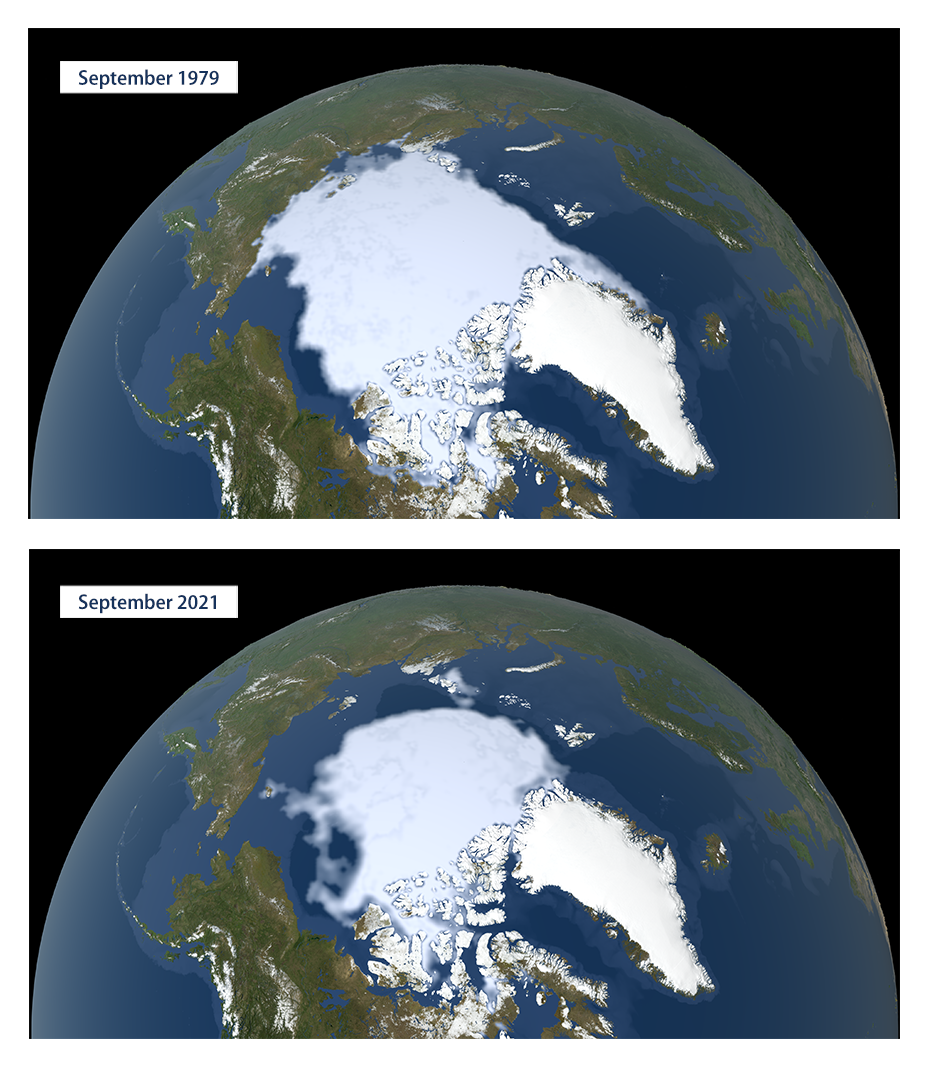
Change in sea ice around the arctic. Top: 1979. Bottom: 2021. (Source: NASA via EPA).
Image - Text Version
Shown are two separate colour images of the Earth. Each is a view of the northern hemisphere from space.
The top image shows a whiteish ice mass which covers a large part of northern Canada, Greenland and the Arctic Ocean. The background is black. In the top left corner there is a text label that identified the image as having been taken in "September 1979".
The bottom image is of the same part of the world taken at a later date. The ice mass is about 2/3 smaller than the previous image. It covers a smaller area of the Arctic Ocean. In the top left corner there is a text label that identified the image as having been takein in "September 2021".
Conservation
There are efforts being made to protect this unique biome and to reduce human impacts. This includes efforts to reduce levels of greenhouse gases. Canada net-zero explains how Canada plans to do that. Other conservation efforts include creating protected areas and limiting hunting.
Conservation groups like the Ocean Conservancy are interested in helping this biome. These groups help others create sustainable solutions for the arctic.
Learn More
The Unsung Heroes of the Arctic - Ep. 3 | Wildlife: The Big Freeze (2019)
In this video (10:47 min.), from National Geographic learn about some of the unexpected array of smaller species that each have their own peculiar strategies for surviving in the Arctic.
Disappearing Arctic sea ice (2018)
This video (3:30 min.), from NASA Climate Change, shows the age of the Arctic sea ice between 1984 and 2019.
Arctic Biodiversity (2017)
In this video (2:14 min.), from Canada C3, learn about botanic biodiversity of the Arctic.
References
Chen, Z. (2013). Tundra Ecosystems. In Howarth, R. W., & Mohan, J. E. Biomes and ecosystems (pp. 197-199). Salem Press.
Molles Jr., M.C. & Cahill Jr., J.F. (2015). Ecology: Concepts & applications. Mcgraw-Hill Ryerson.
Peacock, E., Derocher, A., Thiemann, G., & Stirling, I. (2011). Conservation and management of Canada’s polar bears (Ursus maritimus) in a changing Arctic. Canadian Journal of Zoology, 89(5), 371–385. DOI: 10.1139/z11-021